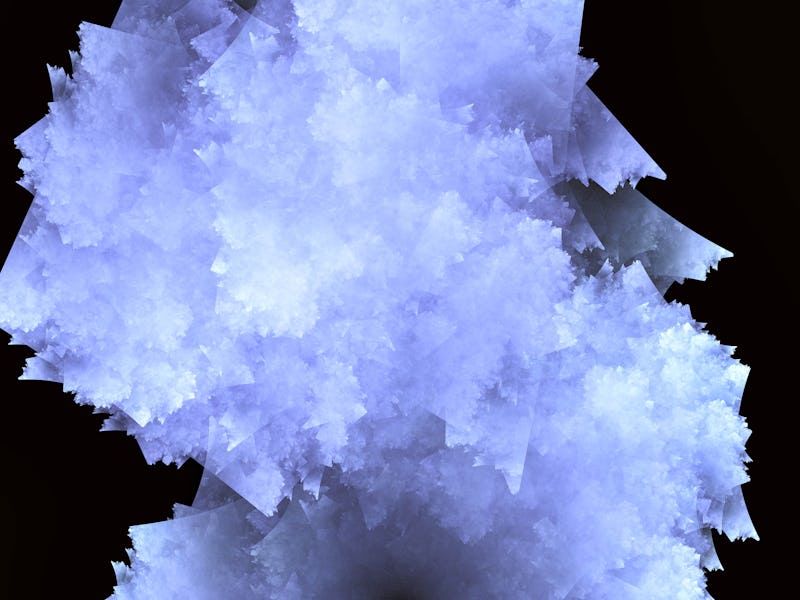Scientists Created A New Type of Ice — It Could Also Exist On Distant Moons
A recent experiment yielded a frozen surprise.

Ice is one of the Universe’s most talented shapeshifters.
Under extremely low temperatures and high pressures, the atoms within ice rearrange themselves. This helps explain why scientists have discovered at least 20 different incarnations of ice in the lab, up in space, or deep within the Earth — some of which have no fixed structure at all.
Now, in a happy accident, scientists appear to have created yet another form. Their results, recently published in the journal Science, may offer our first glimpse at a form of ice that looks a lot like liquid water — potentially transforming our grasp of water and its various quirks.
Salzmann and his team used a technique called ball milling to grind ice — and encountered a surprising result.
What’s new
The researchers used a simple yet elegant recipe. They filled a jar with one part ice and one part stainless steel balls — leaving a third of it empty — and chilled it with liquid nitrogen to around minus 320 degrees Fahrenheit. Then, they shook it vigorously with a machine that could probably make excellent cocktails.
Normally, scientists concoct ice not found on Earth by compressing water or ice. Instead, this technique, known as ball milling, grinds the ice. As the balls tear through the ice, they shear it apart — tearing its atoms from the cozy confines of their lattice.
Cryo-chilled ball milling is commonly used to powderize squishy substances like rubber or cheese, but nobody had ever tried it with ice, Christoph Salzmann, a chemist at University College London and one of the paper authors, tells Inverse. So Salzmann and his colleagues decided to try it out — just to see what happened. “It was just a new thing to do,” he says.
They didn’t expect to find anything more than a finely ground ice powder. What they found was not powder at all.
Here’s the background
The atoms composing many materials slot themselves into standard shapes. For instance, table salt’s sodium and chlorine atoms form cubes. Our familiar Earth ice consists of hexagons, which is why snowflakes have six sides. Overall, most solid materials’ atoms take up one of seven common structures.
But there are exceptions: the free-floaters that scientists call amorphous solids. These have a haphazard architecture of atoms. Glass is considered an amorphous solid; it’s formed by rapidly cooling a molten liquid, giving its atoms zero time to settle. The ice created in the recent experiment also falls into this category, but these aren’t the first scientists to create such chaotic ice.
Researchers have identified two types of amorphous ice: one has a lower density than liquid water and was creatively named low-density amorphous ice (LDA). The denser version is, unsurprisingly, called high-density amorphous ice (HDA).
The team managed to make MDA in a lab, but it remains highly mysterious because scientists don’t yet know how its formation relates to LDA or HDA.
This newly discovered ice has a density similar, if not equal, to that of liquid water. So the form conceived by Salzmann’s team — dubbed medium-density amorphous ice (MDA) — could sit neatly between the other two forms. “I can only assume that they never expected to see this medium-density ice,” Anders Nilsson, a physicist at Stockholm University who was not involved in the recent study, tells Inverse.
Only, the entire scheme may not actually be neat at all. No one knows how MDA’s formation relates to LDA or HDA, if at all. What’s more, computer analysis and modeling of MDA’s properties suggest that its structure is very similar to liquid water, hinting at a link that scientists haven’t uncovered yet. It’s possible that MDA essentially retains the messy atomic order of the water it formed from.
“I haven’t got a clue at the moment,” says Salzmann.
Why it matters
On Earth, surrounded by delicate snow and iced drinks, it’s easy to assume that most solid water resembles the ice we’re all familiar with. But the vast majority of the Universe is extremely cold and lacks an atmosphere.
In those conditions, when water molecules coalesce around grains of cosmic dust, they settle as LDA. This means that the vast majority of the Universe’s water is probably amorphous. If that’s the case, we might find MDA somewhere out there in space.
MDA may be discovered among the Solar System’s icy moons, including Europa.
Take the icy moons of the Solar System: for instance, Europa, Ganymede, and Callisto, all of which orbit Jupiter. The gas giant’s formidable gravity might tear at those moons’ ice with shearing forces similar to the inside of a ball mill. Salzmann speculates that MDA may hide somewhere within those far-off worlds.
“Since it’s not been discovered before, it’s probably not that easy to form this particular amorphous ice,” Nilsson says. “So you probably need to have these additional forces on it that the ball milling generated.”
What’s next
More tests are in order — for instance, examining MDA through an electron microscope, according to Salzmann. Nilsson also thinks the team should probe it with the high-powered X-rays from a synchrotron for more insight into the strange ice’s structure.
If MDA does exist in the Solar System’s moons, it would probably occur in close combination with minerals and other materials. Salzmann says the authors plan to add in other substances and see if any make a mark on MDA’s creation.
Meanwhile, in April, the European Space Agency’s JUICE mission will take off for a tour of Jupiter’s moons. Next year, NASA’s Europa Clipper will head up to join it. When both probes reach their destinations around 2030, scientists may encounter a golden opportunity to seek out MDA on distant moons.